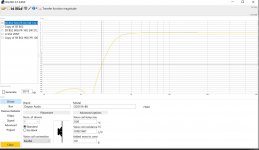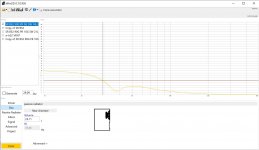If you think (or know from measurements - Audacity is your friend here) that the program material you will be playing back has strong content below 30Hz then a high pass filter between your source & amp would be a good idea.
They are independent parameters. The excursion will occur with no audible output if the signal is passed to the woofer.
So to your question, the answer is yes.
So to your question, the answer is yes.
thank you David Morison and Sangram.
is a pre amp high pass filter a product I can buy or an electricity circuit I need to make fairly easy?
is a pre amp high pass filter a product I can buy or an electricity circuit I need to make fairly easy?
something like this? (actually it's too expensive and dose not ship to IL)
Amazon.com: Harrison Labs FMOD Inline Crossover Pair 30 Hz High Pass RCA: Electronics
according to WINSPL a 25HZ n2 butterworth filter will do a god job.
Amazon.com: Harrison Labs FMOD Inline Crossover Pair 30 Hz High Pass RCA: Electronics
according to WINSPL a 25HZ n2 butterworth filter will do a god job.
Last edited:
Inline crossovers like those are 6dB/octave (at best). They are not sufficient for preventing excursion, though you can model it.
Depending on what kind of music you listen to, the excess mechanical stress may or may not be damaging to the driver.
Project 99 - Subsonic Filter
Depending on what kind of music you listen to, the excess mechanical stress may or may not be damaging to the driver.
Project 99 - Subsonic Filter
It depend what you call easy.thank you David Morison and Sangram.
is a pre amp high pass filter a product I can buy or an electricity circuit I need to make fairly easy?
Active High Pass Filter
Subsaver - Free Speaker Design Software
I will claim that 99% of all speaker/amp combos that have been sold in history didnt have the HP filter. They were fine anyway. Just use your ears. If it sounds bad or the cones of your woofers are flapping around, lower the volume...
This is a subwoofer, where 99% of all commercial products actually do have a HP filter to prevent over-excursion. This is done to avoid warranty claims and 'farting' from over-excursion.
Even so, commercial products are very often not an example of best practices, in almost any area. Most of the actual work is done by accounts and marketing, and very little by actual engineers.
Even so, commercial products are very often not an example of best practices, in almost any area. Most of the actual work is done by accounts and marketing, and very little by actual engineers.
thank you David Morison and Sangram.
is a pre amp high pass filter a product I can buy or an electricity circuit I need to make fairly easy?
You certainly can buy, though if cost is an issue the DIY links you've already been given may be preferable to you.
One reason I didn't suggest any specific gear earlier is that I don't know the rest of your rig, which may influence what's optimum for you.
If your amp has DSP onboard already like many Home Theatre style receivers, you may be able to access the relevant setting in that, and not need any extra gear at all.
Likewise if your main playback source is from a computer there must be plenty of programs you can download to allow frequency response shaping before sending the signal to the amps.
If you're still wanting to buy, then anything from moderately cheap (ie under £100) to many thousands of pounds cost could sort you out - at the cheap end of the scale, this might be worth a look: Thomann DSP.
Obviously, that allows you to do far more than just the HPF, but is probably the cheapest unit you can get that's basically fully configurable.
One caveat is that it's designed for balanced signal input at a slightly higher level than home hi-fi typically operates at, so you may risk a slightly higher noise floor.
If you prefer analogue, this: Behringer crossover is similarly priced and has 25Hz 12dB high pass filters available - I'm not certain they're Butterworth aligned, but it's a good probability that they are that type.
HTH,
David.
This is a very common issue in the DIY large sub community where xmas skyrockets below 20hz.

The common solutions there seem to be one of two things.. get a pro amp with a dsp or infrasonic filter built in (like a behringer "D" series), or get a minidsp and tune it with your computer.
Other folks have designed their own passives or used the above recommendations. Its a bummer that folks dont think the fmods will work - they are listed as 12db but everyone seems to think they are 6db. You can model it to see if thats enough.
The common solutions there seem to be one of two things.. get a pro amp with a dsp or infrasonic filter built in (like a behringer "D" series), or get a minidsp and tune it with your computer.
Other folks have designed their own passives or used the above recommendations. Its a bummer that folks dont think the fmods will work - they are listed as 12db but everyone seems to think they are 6db. You can model it to see if thats enough.
My recent modeling taught me we really really need to be putting HP filters on our subs. I was mistaken about how sealed systems work.
The situation is worse than the graphs due to the greatly increased distortion. Seems 5% can turn into 50 pretty quick. A simple first order, 20 to 25 Hz is all I think I need, but I have no use for 18 Hz special effects or some ego FR plot showing flat to almost DC. Room gain takes care of the roll-off close enough eq can handle the rest.
I used the Berhginger x-over for years. OK for the subs but audible on the mains. Waiting today I hope for a pair of XKitz boards.
Sim in WinISL suggests a first order wil be sufficient for my drivers. I can cobble together a 2nd order active if I need to.
The situation is worse than the graphs due to the greatly increased distortion. Seems 5% can turn into 50 pretty quick. A simple first order, 20 to 25 Hz is all I think I need, but I have no use for 18 Hz special effects or some ego FR plot showing flat to almost DC. Room gain takes care of the roll-off close enough eq can handle the rest.
I used the Berhginger x-over for years. OK for the subs but audible on the mains. Waiting today I hope for a pair of XKitz boards.
Sim in WinISL suggests a first order wil be sufficient for my drivers. I can cobble together a 2nd order active if I need to.
So maybe someone should try a Fmod then if a 6db slope is sufficient to reduce sub 20hz xmax issues? I'd love to see some real data on this because for $30 its a great solution.
There is a fairly simple formula for acoustic output. Source surface area, excursion, frequency.
Can't find it at the moment, sorry!
Can't find it at the moment, sorry!
I am by no means an expert in WinISD. I've built a bunch of sub boxes, but I'm still learning about the newer box analysis apps, etc, but anywhoo, I ran some winisd calcs.
Without any other processing/filtering, if a 6db highpass fmod at 20hz is applied as a filter, on an eminence 21", you will avoid hitting xmax (@12hz) until you apply 1700watts. This is in a full marty 11.83cuft box tuned to 19hz.
The fmod says its a 12db xover, but I read someone said its more like 6db/1st order. If we believe the spec sheet, and apply a 12db fmod, we dont hit xmax (@14hz) until 3200watts.
BTW I just saw they make fmods in xlr format now. Pretty cool, lil exspensive though $65..
Without any other processing/filtering, if a 6db highpass fmod at 20hz is applied as a filter, on an eminence 21", you will avoid hitting xmax (@12hz) until you apply 1700watts. This is in a full marty 11.83cuft box tuned to 19hz.
The fmod says its a 12db xover, but I read someone said its more like 6db/1st order. If we believe the spec sheet, and apply a 12db fmod, we dont hit xmax (@14hz) until 3200watts.
BTW I just saw they make fmods in xlr format now. Pretty cool, lil exspensive though $65..
- Home
- Loudspeakers
- Subwoofers
- cone excursion in low HZ

